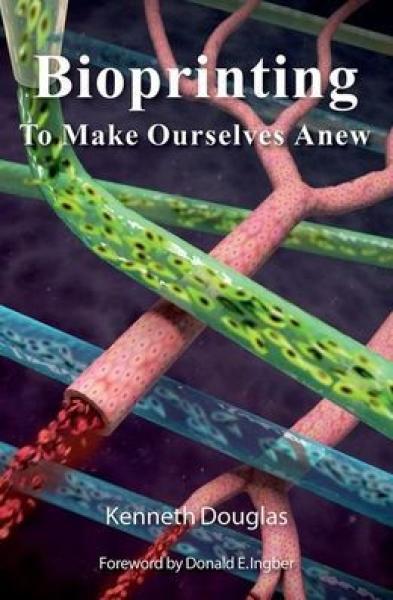Description
As the 21st century dawned, a handful of inspired scientists tried to use 3D printing to create living human tissue. Their vision was to restore the health of people with intractable injuries, such as worn out cartilage, severed nerves, ailing kidneys, failing hearts--the gamut of human frailties.
Their modest success energized others to join the quest. Now, after two decades of ingenious effort and hard work, they have carved out a vibrant new discipline: bioprinting.
In Bioprinting: To Make Ourselves Anew, physicist Kenneth Douglas casts an eye over the achievements and future of bioprinting. He explains the science with rigor but with a minimum of technical baggage. This is the first book on the subject written expressly for the lay audience: accessible and
even entertaining. Douglas interviewed two dozen bioprinting researchers from around the world, and he enriches the narrative by sharing stories from the scientists behind the science. These contemporary vignettes are complemented by historical accounts of the women and men whose prescient
contributions were foundational to the development of bioprinting.
The book describes the challenges and accomplishments in the bioprinting of blood vessels, cartilage, skin, bone, skeletal muscle, neuromuscular junctions, liver, heart, lung, kidney, and so-called organs-on-a-chip, as well as the challenges of providing a blood supply and nerves to bioprinted
tissues. This is a compelling tale of a work in progress: to imitate nature and help heal people with debilitating afflictions.
"Bioprinting: To Make Ourselves Anew describes how bioprinting emerged from 3D printing and details the accomplishments and challenges in bioprinting tissues of cartilage, skin, bone, muscle, neuromuscular junctions, liver, heart, lung, and kidney. It explains how scientists are attempting to provide these bioprinted tissues with a blood supply and the ability to carry nerve signals so that the tissues might be used for transplantation into persons with diseased or damaged organs. The book presents all the common terms in the bioprinting field and clarifies their meaning using plain language. The reader will learn about bioink-a bioprinting material containing living cells and supportive biomaterials. Additionally, readers will become at ease with concepts such as fugitive inks (sacrificial inks used to make channels for blood flow), extracellular matrices (the biological environment surrounding cells), decellularization (the process of isolating cells from their native environment), hydrogels (water-based substances that can substitute for the extracellular matrix), rheology (the flow properties of a bioink), bioreactors (containers to provide the environment cells need to thrive and multiply). Further vocabulary that will become familiar includes diffusion (passive movement of oxygen and nutrients from regions of high concentration to regions of low concentration), stem cells (cells with the potential to develop into different bodily cell types), progenitor cells (early descendants of stem cells), gene expression (the process by which proteins develop from instructions in our DNA), and growth factors (substances-often proteins-that stimulate cell growth, proliferation, and differentiation). The book contains an extensive glossary for quick reference"--
"This book is superb! Ken Douglas has an amazing talent for weaving in and out of complicated topics and making them easy to understand. He writes in an engaging, conversational style, taking the reader inside the laboratory and introducing the personalities behind the science. Using down-to-earth
examples and descriptive language, he makes complex scientific concepts come to life for the general public. He has done a magnificent job outlining what has been accomplished to date and the challenges that remain. Well done, Ken Douglas!" -- Anthony Atala, MD, G. Link Professor and Director, Wake
Forest Institute for Regenerative Medicine
"The amount and breadth of basic research in bioprinting is astounding. It is a huge mix of approaches with cell biology, tissue engineering, and printing methods that start from scratch with basic cells and create living tissues. Douglas takes us through this maze step by step and makes historical
and clinical sense of the direction and pace of this research." -- Charles "Chuck" W. Hull, Inventor of Stereolithography (a.k.a. 3D Printing); Co-Founder, Executive Vice President, and Chief Technical Officer, 3D Systems
"In this book, Ken Douglas tells how bioprinting first emerged at the turn of the 21st century, the enormous potential it offers for transforming the field of organ transplantation, and the real challenges that must be overcome in order for it to succeed and have an impact on the future of health
care. It is a story of creativity, drive, perseverance, and passion, and it is told by recounting the personal stories of many of the key scientists who have led the chase." -- From the Foreword by Donald E. Ingber, MD, Director, Wyss Institute for Biologically Inspired Engineering, Harvard
University
"Magic happens when we combine a 3D printer with tissue engineering and regenerative medicine. Add materials science, biotechnology, and medical technology, and the result is an explosion of innovation in 3D engineered tissues. Through a storytelling method, this fine book provides readers with
insights into how bioprinting has changed tissue engineering and regenerative medicine and how it can change the way we approach human diseases in the future." -- Dong-Woo Cho, Nam-Go Chair Professor, Department of Mechanical Engineering, Pohang University of Science and Technology (POSTECH), South
Korea; Director, Center for Rapid Prototyping-Based 3D Tissue/Organ Printing
Product Details
- Oxford University Press, Brand
- May 28, 2021 Pub Date:
- 0190943548 ISBN-10:
- 9780190943547 ISBN-13:
- 320 Pages
- 9.3 in * 6.2 in * 0.9 in Dimensions:
- 2 lb Weight:




